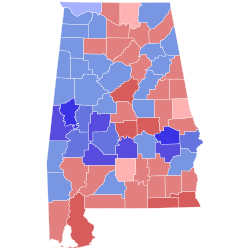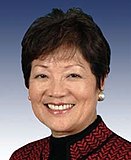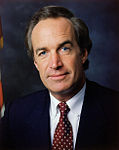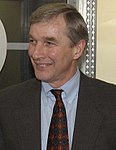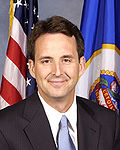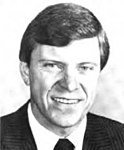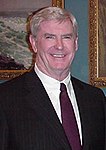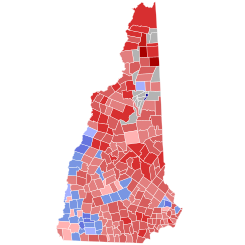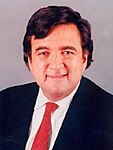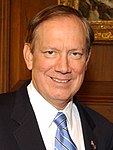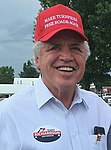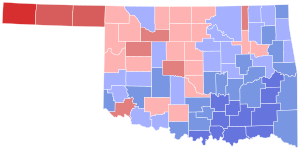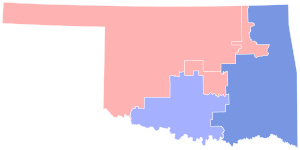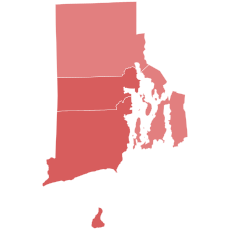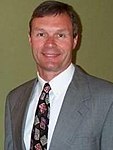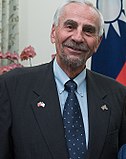2002 United States gubernatorial elections
| |||||||||||||||||||||||||||||||||||||||||||||||||||||||||||
38 governorships 36 states; 2 territories | |||||||||||||||||||||||||||||||||||||||||||||||||||||||||||
|---|---|---|---|---|---|---|---|---|---|---|---|---|---|---|---|---|---|---|---|---|---|---|---|---|---|---|---|---|---|---|---|---|---|---|---|---|---|---|---|---|---|---|---|---|---|---|---|---|---|---|---|---|---|---|---|---|---|---|---|
| |||||||||||||||||||||||||||||||||||||||||||||||||||||||||||
 Map of the results Republican hold Republican gain Democratic hold Democratic gain No election | |||||||||||||||||||||||||||||||||||||||||||||||||||||||||||
United States gubernatorial elections were held on November 5, 2002, in 36 states and two
Overall, the Republicans suffered a net loss of one seat while the Democrats made a net gain of three. The Republicans managed to maintain their majority of state governorships, but it was reduced to a margin of only two seats. The elections were notable for the sheer number of state governorships that changed parties – 20 in total, constituting more than half of the seats up for election. Additionally, a number of Democratic and Republican gains occurred in states that typically favor the other party; for instance, Republican candidates won the usually Democratic states of Maryland, Hawaii, Minnesota and Vermont, while Democratic governors were elected in Republican-leaning states like Wyoming, Tennessee, Oklahoma and Kansas.
As of 2024, this election marks the most recent cycle in which Colorado or New York elected a Republican governor.
Election ratings
| State | Incumbent | Last race |
Result | ||
|---|---|---|---|---|---|
| Alabama | Don Siegelman | 57.9% D | Lean R (flip) | Tossup | Riley (49.2%) |
| Alaska | Tony Knowles (Term-limited) |
51.3% D | Lean R (flip) | Tossup | Murkowski (55.8%) |
| Arizona | Jane Dee Hull (Term-limited) |
60.9% R | Lean D (flip) | Tossup | Napolitano (46.2%) |
| Arkansas | Mike Huckabee | 59.7% R | Lean R | Tossup | Huckabee (53.0%) |
| California | Gray Davis | 58.0% D | Likely D | Lean D | Davis (47.3%) |
| Colorado | Bill Owens | 49.1% R | Safe R | Safe R | Owens (62.8%) |
| Connecticut | John G. Rowland | 62.9% R | Likely R | Likely R | Rowland (56.1%) |
| Florida | Jeb Bush | 55.3% R | Leans R | Tossup | Bush (56.0%) |
| Georgia | Roy Barnes | 52.5% D | Likely D | Likely D | Perdue (51.4%) |
| Hawaii | Ben Cayetano (Term-limited) |
50.1% D | Lean R (flip) | Tossup | Lingle (51.6%) |
| Idaho | Dirk Kempthorne | 67.7% R | Lean R | Safe R | Kempthorne (56.3%) |
| Illinois | George Ryan (Retired) |
51.0% R | Safe D (flip) | Lean D (flip) | Blagojevich (52.2%) |
| Iowa | Tom Vilsack | 52.3% D | Leans D | Tossup | Vilsack (52.7%) |
| Kansas | Bill Graves (term-limited) |
73.4% R | Lean D (flip) | Lean D (flip) | Sebelius (52.9%) |
| Maine | Angus King (term-limited) |
58.6% I | Likely D (flip) | Lean D (flip) | Baldacci (47.2%) |
| Maryland | Parris Glendening | 55.1% D | Leans R (flip) | Tossup | Ehrlich (51.6%) |
| Massachusetts | Jane Swift (Retired) |
50.0% R | Leans D (flip) | Tossup | Romney (49.8%) |
| Michigan | John Engler (term-limited) |
62.2% R | Likely D (flip) | Lean D (flip) | Granholm (51.4%) |
| Minnesota | Jessie Ventura (retired) |
37.0% Re | Lean R (flip) | Tossup | Pawlenty (44.4%) |
| Nebraska | Mike Johanns | 53.9% R | Safe R | Safe R | Johanns (68.7%) |
| Nevada | Kenny Guinn | 51.6% R | Safe R | Safe R | Guinn (68.2%) |
| New Hampshire | Jeanne Shaheen (retired) |
48.8% D | Likely R (flip) | Lean R (flip) | Craig Benson (58.6%) |
| New Mexico | Gary Johnson (term-limited) |
54.5% R | Likely D (flip) | Likely D (flip) | Richardson (55.5%) |
| New York | George Pataki | 54.3% R | Likely R | Likely R | Pataki (49.4%) |
| Ohio | Bob Taft | 50.0% R | Likely R | Safe R | Taft (57.8%) |
| Oklahoma | Frank Keating (term-limited) |
57.3% R | Lean R | Likely R | Henry (43.3%) |
| Oregon | John Kitzhaber (term-limited) |
64.4% D | Lean D | Leans D | Kulongoski (49.0%) |
| Pennsylvania | Mark Schweiker (retired) |
57.4% R | Likely D (flip) | Lean D (flip) | Rendell (53.4%) |
| Rhode Island | Lincoln Almond (term-limited) |
51.0% R | Lean D (flip) | Tossup | Carcieri (54.8%) |
| South Carolina | Jim Hodges | 53.2% D | Lean R (flip) | Tossup | Sanford (52.9%) |
| South Dakota | Bill Janklow (term-limited) |
64.0% R | Likely R | Lean R | Rounds (56.8%) |
| Tennessee | Don Sundquist (term-limited) |
68.8% R | Lean D (flip) | Tossup | Bredesen (50.7%) |
| Texas | Rick Perry | 68.2% R | Likely R | Lean R | Perry (57.8%) |
| Vermont | Howard Dean (retired) |
50.5% D | Lean R (flip) | Tossup | Douglas (44.9%) |
| Wisconsin | Scott McCallum | 59.7% R | Lean D (flip) | Tossup | Doyle (45.1%) |
| Wyoming | Jim Geringer (term-limited) |
55.66 R | Lean R | Tossup | Freudenthal (50.0%) |
Race Summary
States
| State | Incumbent | Party | First elected |
Result | Candidates |
|---|---|---|---|---|---|
| Alabama | Don Siegelman | Democratic | 1998 | Incumbent lost re-election. New governor elected. Republican gain. |
|
| Alaska | Tony Knowles | Democratic | 1994 | Incumbent term-limited. New governor elected. Republican gain. |
|
| Arizona | Jane Dee Hull | Republican | 1997[b] | Incumbent term-limited. New governor elected. Democratic gain. |
|
| Arkansas | Mike Huckabee | Republican | 1996[c] | Incumbent re-elected. |
|
| California | Gray Davis | Democratic | 1998 | Incumbent re-elected. |
|
| Colorado | Bill Owens | Republican | 1998 | Incumbent re-elected. |
|
| Connecticut | John G. Rowland | Republican | 1994 | Incumbent re-elected. |
|
| Florida | Jeb Bush | Republican | 1998 | Incumbent re-elected. |
|
| Georgia | Roy Barnes | Democratic | 1998 | Incumbent lost re-election. New governor elected. Republican gain. |
|
| Hawaii | Ben Cayetano | Democratic | 1994 | Incumbent term-limited. New governor elected. Republican gain. |
|
| Idaho | Dirk Kempthorne | Republican | 1998 | Incumbent re-elected. |
|
| Illinois | George Ryan | Republican | 1998 | Incumbent retired. New governor elected. Democratic gain. |
|
| Iowa | Tom Vilsack | Democratic | 1998 | Incumbent re-elected. |
|
| Kansas | Bill Graves | Republican | 1994 | Incumbent term-limited. New governor elected. Democratic gain. |
|
| Maine | Angus King | Independent | 1994 | Incumbent term-limited. New governor elected. Democratic gain. |
|
| Maryland | Parris Glendening | Democratic | 1994 | Incumbent term-limited. New governor elected. Republican gain. |
|
| Massachusetts | Jane Swift | Republican | 2001[d] | Incumbent retired. New governor elected. Republican hold. |
|
| Michigan | John Engler | Republican | 1990 | Incumbent term-limited. New governor elected. Democratic gain. |
|
| Minnesota | Jesse Ventura | Independence[e] | 1998 | Incumbent retired. New governor elected. Republican gain. |
|
| Nebraska | Mike Johanns | Republican | 1998 | Incumbent re-elected. |
|
| Nevada | Kenny Guinn | Republican | 1998 | Incumbent re-elected. |
|
| New Hampshire | Jeanne Shaheen | Democratic | 1996 | Incumbent retired to run for U.S. Senator. New governor elected. Republican gain. |
|
| New Mexico | Gary Johnson | Republican | 1994 | Incumbent term-limited. New governor elected. Democratic gain. |
|
| New York | George Pataki | Republican | 1994 | Incumbent re-elected. |
|
| Ohio | Bob Taft | Republican | 1998 | Incumbent re-elected. | |
| Oklahoma | Frank Keating | Republican | 1994 | Incumbent term-limited. New governor elected. Democratic gain. |
|
| Oregon | John Kitzhaber | Democratic | 1994 | Incumbent term-limited. New governor elected. Democratic hold. |
|
| Pennsylvania | Mark Schweiker | Republican | 2001[f] | Incumbent retired. New governor elected. Democratic gain. |
|
| Rhode Island | Lincoln Almond | Republican | 1994 | Incumbent term-limited. New governor elected. Republican hold. |
|
| South Carolina | Jim Hodges | Democratic | 1998 | Incumbent lost re-election. New governor elected. Republican gain. |
|
| South Dakota | Bill Janklow | Republican | 1978 1986 (term-limited) 1994 |
Incumbent term-limited. New governor elected. Republican hold. |
|
| Tennessee | Don Sundquist | Republican | 1994 | Incumbent term-limited. New governor elected. Democratic gain. |
|
| Texas | Rick Perry | Republican | 2000[g] | Incumbent elected to full term. |
|
| Vermont | Howard Dean | Democratic | 1991[h] | Incumbent retired. New governor elected. Republican gain. |
|
| Wisconsin | Scott McCallum | Republican | 2001[i] | Incumbent lost election to full term. New governor elected. Democratic gain. |
|
| Wyoming | Jim Geringer | Republican | 1994 | Incumbent term-limited. New governor elected. Democratic gain. |
|
Territories and federal district
| Territory | Incumbent | Party | First elected |
Result | Candidates |
|---|---|---|---|---|---|
| District of Columbia | Anthony A. Williams | Democratic | 1998 | Incumbent re-elected. |
|
| Guam | Carl Gutierrez | Democratic | 1994 | Incumbent lost renomination. New governor elected. Republican gain. |
|
| U.S. Virgin Islands | Charles Turnbull
|
Democratic | 1998 | Incumbent re-elected. |
|
Closest races
States where the margin of victory was under 1%:
- Alabama, 0.2%
- Oklahoma, 0.7%
States where the margin of victory was under 5%:
- Arizona, 1.0%
- Wyoming, 2.0%
- Vermont, 2.5%
- Oregon, 2.9%
- Tennessee, 3.1%
- Wisconsin, 3.7%
- Maryland, 3.9%
- Michigan, 4.0%
- Hawaii, 4.6%
- Massachusetts, 4.8%
- California, 4.9%
States where the margin of victory was under 10%:
- Georgia, 5.2%
- Maine, 5.7%
- South Carolina, 5.9%
- Arkansas, 6.1%
- Illinois, 7.1%
- Kansas, 7.8%
- Minnesota, 7.9%
- Iowa, 8.2%
- Pennsylvania, 9.0%
- Rhode Island, 9.5%
Alabama
| |||||||||||||||||
| |||||||||||||||||
Riley: 40–50% 50–60% 60–70% Siegelman: 40–50% 50–60% 60–70% 70–80% 80–90% | |||||||||||||||||
| |||||||||||||||||
The 2002 Alabama gubernatorial election was held on November 5. The race pitted incumbent Governor
. As of 2023, this is the last time the Governor’s office in Alabama changed partisan control.The result was an extremely narrow victory for Riley. The certified results showed Riley with 672,225 votes to Siegelman's 669,105, a difference of 3,120 votes, or 0.23% of the 1,367,053 votes cast. Sophocleus garnered 23,272 votes, and 2,451 votes were for write-in candidates. The close and controversial election was marked by high turnout.
Alaska
| ||||||||||||||||||||
| ||||||||||||||||||||
 Results by state house district Murkowski: 40–50% 50–60% 60–70% 70–80% Ulmer: 40–50% 50–60% 60–70% 70–80% | ||||||||||||||||||||
| ||||||||||||||||||||
The 2002 Alaska gubernatorial election took place on November 5, 2002, for the post of
Arizona
| |||||||||||||||||||||
| Turnout | 56.33%[3] | ||||||||||||||||||||
|---|---|---|---|---|---|---|---|---|---|---|---|---|---|---|---|---|---|---|---|---|---|
| |||||||||||||||||||||
 County results Napolitano: 40–50% 50–60% 60–70% Salmon: 40–50% 50–60% | |||||||||||||||||||||
| |||||||||||||||||||||
The 2002 Arizona gubernatorial election took place on November 5, 2002. Incumbent Republican Governor Jane Dee Hull was term-limited. The Democratic nominee, Arizona Attorney General Janet Napolitano, narrowly defeated Republican Matt Salmon, a former U.S. Representative. Upon her inauguration, Napolitano became the first woman to succeed another woman as Governor of a state. Until 2022, this was the last gubernatorial election in Arizona in which the margin of victory was single digits.
Arkansas
| |||||||||||||||||
| |||||||||||||||||
 County results Huckabee: 50–60% 60–70% | |||||||||||||||||
| |||||||||||||||||
The 2002 Arkansas gubernatorial election took place on November 5, 2002 for the post of
California
| |||||||||||||||||||||
| Turnout | 36.05% | ||||||||||||||||||||
|---|---|---|---|---|---|---|---|---|---|---|---|---|---|---|---|---|---|---|---|---|---|
| |||||||||||||||||||||
 County results Davis: 40–50% 50–60% 60–70% Simon: 40–50% 50–60% 60–70% | |||||||||||||||||||||
| |||||||||||||||||||||
The 2002 California gubernatorial election was an election that occurred on November 5, 2002. Democrat Gray Davis defeated Republican Bill Simon by 5% and was re-elected to a second four-year term as Governor of California. Davis would be recalled less than a year into his next term.
The 2002 gubernatorial primary occurred in March 2002. Gray Davis faced no major competitor in the primary and won the nomination. Simon defeated former
Colorado
| ||||||||||||||||||||
| ||||||||||||||||||||
 County results Owens: 40–50% 50–60% 60–70% 70–80% 80–90% Heath: 40–50% 50–60% | ||||||||||||||||||||
| ||||||||||||||||||||
The 2002 Colorado gubernatorial election was held on November 5, 2002 to elect the governor of Colorado. Bill Owens, the Republican incumbent, defeated Democratic nominee Rollie Heath to win a second term. Owen's win set the record for biggest win by a Republican in a Colorado gubernatorial election (Democrats won by larger margins in 1982, 1948, and 1928, with Billy Adams' 35 point blowout in that year being the greatest victory for a candidate of any party).[4] As of 2024, this is the last time a Republican was elected Governor of Colorado.
Connecticut
| ||||||||||||||||||||
| ||||||||||||||||||||
Rowland: 50–60% 60–70% 70–80% Curry: 50–60% 60–70% 70–80% | ||||||||||||||||||||
| ||||||||||||||||||||
The 2002 Connecticut gubernatorial election took place on November 5, 2002. Incumbent Republican Governor John G. Rowland won reelection to a third consecutive term, defeating Democrat Bill Curry. Rowland became the first Connecticut Governor to win a third term in office, but did not finish his term, resigning in 2004 due to allegations of corruption. Despite losing this election, as of 2022, Curry is the last Democratic gubernatorial candidate to carry Windham County.
Florida
| ||||||||||||||||||||
| Turnout | 55.3% | |||||||||||||||||||
|---|---|---|---|---|---|---|---|---|---|---|---|---|---|---|---|---|---|---|---|---|
| ||||||||||||||||||||
 County results Bush: 50–60% 60–70% 70–80% McBride: 50–60% 60–70% 70–80% | ||||||||||||||||||||
| ||||||||||||||||||||
The 2002 Florida gubernatorial election took place on November 5, 2002 for the post of
Georgia
| |||||||||||||||||
| |||||||||||||||||
 County results Perdue: 40–50% 50–60% 60–70% 70–80% Barnes: 40–50% 50–60% 60–70% 70–80% Tie: 40–50% | |||||||||||||||||
| |||||||||||||||||
The 2002 Georgia gubernatorial election was held on November 5, 2002. Incumbent Democratic Governor Roy Barnes sought re-election to a second term as governor. State Senator Sonny Perdue emerged as the Republican nominee from a crowded and hotly contested primary, and he faced off against Barnes, who had faced no opponents in his primary election, in the general election. Though Barnes had been nicknamed "King Roy" due to his unique ability to get his legislative priorities passed, he faced a backlash among Georgia voters due to his proposal to change the state flag from its Confederate design.
Ultimately, Perdue was able to defeat incumbent Governor Barnes and became the first Republican to serve as governor of the state since
Hawaii
| ||||||||||||||||||||
| ||||||||||||||||||||
 County results Lingle: 50–60% Hirono: 50–60% | ||||||||||||||||||||
| ||||||||||||||||||||
The 2002 Hawaii gubernatorial election was held on November 5, 2002, to select the
Ultimately Lingle defeated Hirono in a close election, making her the first Republican Governor of Hawaii elected since 1959 and the state's first-ever female governor. She was the first white governor of the state since 1970. Lingle and Hirono faced off again in Hawaii’s 2012 U.S. Senate election, where Hirono won 63% - 37%, making Lingle the first female Governor and Hirono the first female U.S. Senator in Hawaii history.
Idaho
| |||||||||||||||||
| |||||||||||||||||
 County results Kempthorne: 50–60% 60–70% 70–80% Brady: 40–50% 50–60% | |||||||||||||||||
| |||||||||||||||||
The 2002 Idaho gubernatorial election was held on November 5, 2002 to select the
Illinois
| ||||||||||||||||||||
| Turnout | 50.05% | |||||||||||||||||||
|---|---|---|---|---|---|---|---|---|---|---|---|---|---|---|---|---|---|---|---|---|
| ||||||||||||||||||||
 County results Blagojevich: 40–50% 50–60% 60–70% Ryan: 40–50% 50–60% 60–70% 70–80% | ||||||||||||||||||||
| ||||||||||||||||||||
The 2002 Illinois gubernatorial election occurred on November 5, 2002. Incumbent Republican governor George Ryan, who was plagued by scandal, did not run for a second term. Democrat Rod Blagojevich, a U.S. Congressman, ran against Republican Jim Ryan (no relation to the incumbent), the Illinois Attorney General. Blagojevich won 52% to 45%, becoming the first Democrat to win an election for governor since 1972. As of 2023 this is the last Illinois governor election where no candidate running was an incumbent.
Iowa
| |||||||||||||||||
| |||||||||||||||||
 County results Vilsack: 40–50% 50–60% 60–70% Gross: 40–50% 50–60% 60–70% 70-80% 80–90% | |||||||||||||||||
| |||||||||||||||||
The 2002 Iowa gubernatorial election took place November 5, 2002. Incumbent
Kansas
| ||||||||||||||||||||
| ||||||||||||||||||||
 County results Sebelius: 40–50% 50–60% 60–70% 70–80% Shallenburger: 40–50% 50–60% 60–70% Tie: 40–50% | ||||||||||||||||||||
| ||||||||||||||||||||
The 2002 Kansas gubernatorial election was held on November 5, 2002. Incumbent Governor Bill Graves, a Republican, was barred from seeking a third term by the Kansas Constitution. Kansas Insurance Commissioner Kathleen Sebelius, the Democratic nominee, ran against Kansas State Treasurer Tim Shallenburger, the Republican nominee, with Sebelius defeating Shallenburger to become the second female Governor of Kansas after Joan Finney who served as governor from 1991 to 1995.
Maine
| |||||||||||||||||||||
| |||||||||||||||||||||
Baldacci: 30–40% 40–50% 50–60% 60–70% 70–80% 80–90% >90%} Cianchette: 40–50% 50–60% 60–70% 70–80% 80–90% Carter: 50-60% Tie: 40-50% 50% | |||||||||||||||||||||
| |||||||||||||||||||||
The 2002 Maine gubernatorial election took place on November 5, 2002.
.Ultimately, Baldacci prevailed to win what would be his first of two terms as governor. John Baldacci's win marked the first Democratic gubernatorial victory in the state since 1982.[10]
Maryland
| ||||||||||||||||||||
| Turnout | 61.85% | |||||||||||||||||||
|---|---|---|---|---|---|---|---|---|---|---|---|---|---|---|---|---|---|---|---|---|
| ||||||||||||||||||||
 County results Ehrlich: 50–60% 60–70% 70–80% Townsend: 60–70% 70–80% | ||||||||||||||||||||
| ||||||||||||||||||||
The 2002 Maryland gubernatorial election was held on November 5, 2002. Democratic Governor Parris Glendening was term-limited and could not seek a third term. Republican Bob Ehrlich defeated Democrat Kathleen Kennedy Townsend, making him the first Republican governor of Maryland since Spiro Agnew, who served from 1967 to 1969. This was the last time Charles County voted Republican for any office.
This election marked the first time since the 1934 gubernatorial election that a Republican won Maryland without Baltimore City or Montgomery County.[12]
Massachusetts
| ||||||||||||||||||||
| Turnout | 55.29% | |||||||||||||||||||
|---|---|---|---|---|---|---|---|---|---|---|---|---|---|---|---|---|---|---|---|---|
| ||||||||||||||||||||
Romney: 40–50% 50–60% 60–70% 70–80% O'Brien: 40–50% 50–60% 60–70% 70–80% 80–90% >90% Tie: 40–50% | ||||||||||||||||||||
| ||||||||||||||||||||
The 2002 Massachusetts gubernatorial election was held on November 5, 2002. Incumbent Republican acting governor Jane Swift chose not to seek a full term in office. Republican businessman Mitt Romney defeated Democratic Treasurer Shannon O'Brien.
This would be the last time Mitt Romney won this state, as in 2012, he lost the state to Barack Obama by a large margin.
Michigan
| ||||||||||||||||||||
| Turnout | 3,177,565 | |||||||||||||||||||
|---|---|---|---|---|---|---|---|---|---|---|---|---|---|---|---|---|---|---|---|---|
| ||||||||||||||||||||
 County results Granholm: 40–50% 50–60% 60–70% Posthumus: 40–50% 50–60% 60–70% 70–80% | ||||||||||||||||||||
| ||||||||||||||||||||
The 2002 Michigan gubernatorial election was one of the 36 United States
ticket.Granholm won with 51% of the vote, followed by Posthumus' 47%, Campbell with 1%, and Pilchak with less than 1%.[16][17] This made Granholm the first female Michigan governor and the first Democratic governor of Michigan in 12 years.[18]
Minnesota
| |||||||||||||||||||||||||
| |||||||||||||||||||||||||
Pawlenty: 30–40% 40–50% 50–60% 60–70% 70–80% 80–90% >90% Moe: 30–40% 40–50% 50–60% 60–70% 70–80% 80–90% >90% Penny: 30–40% 40–50% 50–60% 60–70% 70–80% 80–90% >90% Tie: 20–30% 30–40% 40–50% 50% | |||||||||||||||||||||||||
| |||||||||||||||||||||||||
The 2002 Minnesota gubernatorial election took place on November 5, 2002 for the post of
Nebraska
| ||||||||||||||||||||
| ||||||||||||||||||||
 County results Johanns: 50–60% 60–70% 70-80% 80–90% | ||||||||||||||||||||
| ||||||||||||||||||||
The 2002 Nebraska gubernatorial election, held on November 5, 2002, featured
This was the first
Nevada
| |||||||||||||||||
| |||||||||||||||||
 County results Guinn: 60–70% 70–80% 80–90% | |||||||||||||||||
| |||||||||||||||||
The 2002 Nevada gubernatorial election took place on November 5, 2002. Incumbent Republican Governor Kenny Guinn defeated Democratic nominee and Nevada Senator Joe Neal in a landslide to win a second term.
New Hampshire
| |||||||||||||||||
| |||||||||||||||||
Benson: 40–50% 50–60% 60–70% 70–80% 80–90% >90% Fernald: 40–50% 50–60% 60–70% >90% | |||||||||||||||||
| |||||||||||||||||
The 2002 New Hampshire gubernatorial election was held on November 5, 2002. Three-term incumbent
This was the only time a Republican was elected governor between 1994 and 2016.
New Mexico
| |||||||||||||||||||||||||
| |||||||||||||||||||||||||
 County results Richardson: 40–50% 50–60% 60–70% 70–80% Sanchez: 40–50% 50–60% 60–70% | |||||||||||||||||||||||||
| |||||||||||||||||||||||||
The 2002 New Mexico gubernatorial election was a race for the Governor of New Mexico. The winner of the election held on November 5, 2002, served from January 1, 2003 until January 1, 2007. Incumbent Republican Gary Johnson was term limited. Former U.S. Congressman Bill Richardson won the election. Green Party nominee David Bacon received over 5% of the total vote, including over 11% in Santa Fe County, which was his best showing.
New York
| |||||||||||||||||||||||||||||
| |||||||||||||||||||||||||||||
 County results Pataki: 40–50% 50–60% 60–70% 70–80% McCall: 40–50% 50–60% 60–70% Golisano: 30–40% | |||||||||||||||||||||||||||||
| |||||||||||||||||||||||||||||
The 2002 New York gubernatorial election was held on November 5, 2002.
On Election Day, Pataki was easily re-elected, but fell short of receiving 50% of the vote. McCall received 33% of the vote, carrying New York City (other than Staten Island) and nearly carrying Albany County. In contrast to the norm for multiple third party campaigns, Golisano did better than his previous elections, receiving 14% of the vote and carrying his home county of Monroe in western New York.
Ohio
| |||||||||||||||||
| |||||||||||||||||
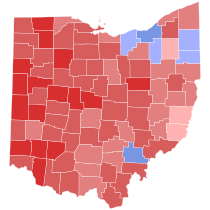 County results Taft: 40–50% 50–60% 60–70% 70–80% Hagan: 40–50% 50–60% | |||||||||||||||||
| |||||||||||||||||
The 2002 Ohio gubernatorial election took place on November 5, 2002. Incumbent
As of 2024, this was the last time that someone other than a current or former member of Congress was elected to the governorship.
Oklahoma
| |||||||||||||||||||||
| |||||||||||||||||||||
Henry: 40–50% 50–60% 60–70% Largent: 40–50% 50–60% 60–70% 70–80% | |||||||||||||||||||||
| |||||||||||||||||||||
The 2002 Oklahoma gubernatorial election was held on November 5, 2002, and was a race for Governor of Oklahoma. Democrat Brad Henry won the election with 43 percent of the vote, beating Republican Steve Largent and conservative independent Gary Richardson.
Henry's narrow win has been attributed to Richardson and Largent's split of the conservative vote
Oregon
| |||||||||||||||||
| |||||||||||||||||
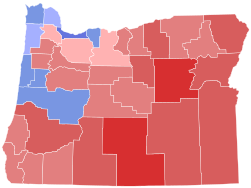 County results
Kulongoski: 40–50% 50–60% 60–70% | |||||||||||||||||
| |||||||||||||||||
The 2002 Oregon gubernatorial election took place on November 5, 2002. Incumbent
Pennsylvania
| ||||||||||||||||||||
| ||||||||||||||||||||
Rendell: 50–60% 60–70% 70–80% 80–90% >90% Swann: 50–60% 60–70% 70–80% 80–90% >90% Tie: 50% No data | ||||||||||||||||||||
| ||||||||||||||||||||
The 2002 Pennsylvania gubernatorial election was held on November 5, 2002, to elect the
Rendell won the election, with commentators attributing his victory to "endless retail politicking" and a hard-working campaign.[25] The political website PoliticsPA praised Rendell's campaign team of David L. Cohen, David W. Sweet, and Sandi Vito.[25] Fisher's strategy backfired; Rendell performed well in much of Eastern Pennsylvania and he was able to win by huge margins in even many traditionally Republican suburbs.[26]
Rendell was the first official from Philadelphia to win the governorship since 1914.[26] This was the first time since 1826 that a Democrat won all four of Philadelphia's suburban counties and the first time since 1970 that a Democrat won Montgomery County in a gubernatorial election.
Rhode Island
| |||||||||||||||||
| |||||||||||||||||
Carcieri: 50–60% 60–70% 70–80% York: 50–60% 60–70% | |||||||||||||||||
| |||||||||||||||||
The 2002 Rhode Island gubernatorial election took place on November 5, 2002. Incumbent Republican Governor Lincoln Almond was term-limited. Republican Donald Carcieri won the open seat, defeating Democrat Myrth York. As of 2022[update], this was the last time the Republican candidate won Providence County.[original research?]
In the Republican primary election, Carcieri defeated James Bennett, who had won the endorsement of the state Republican Party.[27]
The 2002 campaign was particularly costly to York as she spent $3.8 million of her own money to finance what was to be her last bid for elected office. A key turning point in the campaign was when York criticized Carcieri for the actions of businesses he had been associated with but refused to answer Carcieri's request that she reveal what companies her personal assets were invested in.[28]
South Carolina
| |||||||||||||||||
| |||||||||||||||||
 County results Sanford: 50–60% 60–70% Hodges: 50–60% 60–70% 70–80% | |||||||||||||||||
| |||||||||||||||||
The 2002 South Carolina gubernatorial election was held on November 5, 2002 to select the
South Dakota
| ||||||||||||||||||||
| ||||||||||||||||||||
 County results Rounds: 50-60% 60-70% 70-80% 80-90% Abbott: 50–60% 60–70% 70–80% 80–90% | ||||||||||||||||||||
| ||||||||||||||||||||
The 2002 South Dakota gubernatorial election took place on November 2, 2002 to elect a Governor of South Dakota. Republican nominee Mike Rounds was elected, defeating Democratic nominee Jim Abbott.
Tennessee
| |||||||||||||||||
| Turnout | 50.40% | ||||||||||||||||
|---|---|---|---|---|---|---|---|---|---|---|---|---|---|---|---|---|---|
| |||||||||||||||||
 County results Bredesen: 40–50% 50–60% 60–70% 70–80% Hilleary: 40–50% 50–60% 60–70% | |||||||||||||||||
| |||||||||||||||||
The 2002 Tennessee gubernatorial election was held on November 5, 2002, to elect the next
With this win, Bredesen flipped the state back into Democratic control, with the state legislature also being controlled by Democrats.
Texas
| |||||||||||||||||
| |||||||||||||||||
 County results Perry: 50–60% 60–70% 70–80% 80–90% Sanchez: 40–50% 50–60% 60–70% 70–80% 80–90% | |||||||||||||||||
| |||||||||||||||||
The 2002 Texas gubernatorial election was held on November 5, 2002, to elect the
Perry carried 218 out of 254 counties, while Sanchez only carried 36. Exit polls showed Perry easily won among white voters with 72% while Sanchez won the African American vote with 85% and the Latino vote with 65%. His second inauguration for a first full four-year term began on January 21, 2003, on the Texas State Capitol South Grounds.
As of 2022[update], this was the last time the Republican candidate carried Dallas County, and the last time Republicans kept the vote margins within the single digits in Travis County.
Vermont
| |||||||||||||||||||||
| |||||||||||||||||||||
Douglas: 30-40% 40-50% 50-60% 60-70% 70-80% 80-90% Racine: 30-40% 40-50% 50-60% 60-70% 70-80% | |||||||||||||||||||||
| |||||||||||||||||||||
The 2002 Vermont gubernatorial election took place on November 5, 2002. Incumbent Democratic Governor Howard Dean did not run for re-election to a sixth full term as Governor of Vermont. Republican Jim Douglas defeated Democratic candidate Doug Racine and independent candidate Cornelius Hogan, among others, to succeed him. Since no candidate received a majority in the popular vote, Douglas was elected by the Vermont General Assembly per the state constitution.[30]
The race was very close, with Douglas prevailing by just under 6,000 votes or 2.56%. In Vermont for statewide/executive races if no candidate receives 50% then the Vermont General Assembly picks the winner. However, Racine declined to contest it further and conceded to Douglas. Ultimately it was Douglas's strong performance in Montpelier and Rutland that carried him to victory. Racine did do well in populous Burlington and greater Chittenden County, but it ultimately did not suffice. Racine called Douglas at 12:38 P.M. EST and conceded defeat. Douglas would go on to be reelected three more times. Racine would run for governor one last time in 2010, but narrowly lost the Democratic Primary to Peter Shumlin. After the close contest, Shumlin chose Racine to be his Secretary of Human Services. Racine stepped down from that post in 2014.
Wisconsin
| |||||||||||||||||||||
| Turnout | 45.43% | ||||||||||||||||||||
|---|---|---|---|---|---|---|---|---|---|---|---|---|---|---|---|---|---|---|---|---|---|
| |||||||||||||||||||||
Doyle: 30–40% 40–50% 50–60% 60–70% 70–80% 80–90% >90% McCallum: 30–40% 40–50% 50–60% 60–70% 70–80% 80–90% >90% Thompson 30–40% 40–50% 50–60% 60–70% Tie: No data: | |||||||||||||||||||||
| |||||||||||||||||||||
The 2002 Wisconsin gubernatorial election was held on November 5, 2002. Incumbent Republican Governor of Wisconsin Scott McCallum, who had assumed office upon the resignation of Tommy Thompson, ran for his first full term in office. McCallum won his party's nomination by defeating two minor candidates, and Attorney General of Wisconsin Jim Doyle won the Democratic primary with a little more than a third of the vote in a highly competitive primary election. In the general election, the presence of Ed Thompson, former Governor Tommy Thompson's younger brother, the Mayor of Tomah, and the Libertarian Party nominee, held both McCallum and Doyle to under fifty percent of the vote, enabling Doyle to win with 45% of the vote, defeating McCallum.
Wyoming
| |||||||||||||||||
| |||||||||||||||||
 County results Freudenthal: 50–60% 60–70% Bebout: 40–50% 50–60% 60–70% | |||||||||||||||||
| |||||||||||||||||
The 2002 Wyoming gubernatorial election was held on November 5, 2002. Incumbent
Territories and federal district
District of Columbia
| Party | Candidate | Votes | % | |
|---|---|---|---|---|
Democratic
|
Anthony A. Williams (incumbent) | {{{votes}}} | 60.6% | |
Republican
|
Carol Schwartz | {{{votes}}} | 34.5% | |
| DC Statehood Green | Steve Donkin | {{{votes}}} | 2.5% | |
| Total votes | {{{votes}}} | 100.00 | ||
Democratic hold
| ||||
Guam
| Party | Candidate | Votes | % | |
|---|---|---|---|---|
Republican
|
Felix Perez Camacho | {{{votes}}} | 55.4% | |
Democratic
|
Robert A. Underwood | {{{votes}}} | 44.5% | |
| Total votes | {{{votes}}} | 100.00 | ||
Democratic
| ||||
U.S. Virgin Islands
| Party | Candidate | Votes | % | |
|---|---|---|---|---|
Democratic
|
Charles Turnbull (incumbent) | {{{votes}}} | 50.1% | |
Independent
|
John P. de Jongh
|
{{{votes}}} | 24.5% | |
| Total votes | {{{votes}}} | 100.00 | ||
Democratic hold
| ||||
See also
Notes
- ^ Vote total does not include votes for the Reform Party or the Independence Party of New York.
- ^ Hull took office after her predecessor (Fife Symington) resigned. She was subsequently elected in the 1998 Arizona gubernatorial election.
- ^ Huckabee took office after his predecessor (Jim Guy Tucker) resigned. He was subsequently elected in the 1998 Arkansas gubernatorial election.
- ^ Swift took office after her predecessor (Paul Cellucci) resigned.
- ^ The Minnesota Independence Party was known as the Reform Party of Minnesota until 2000.
- ^ Schweiker took office after his predecessor (Tom Ridge) resigned.
- ^ Perry took office after his predecessor (George W. Bush) resigned to become President of the United States.
- Richard Snelling) died. He was subsequently elected in the 1992 Vermont gubernatorial election.
- ^ McCallum took office after his predecessor (Tommy Thompson) resigned.
References
- ^ "Governors Races". www.centerforpolitics.org. November 4, 2002. Archived from the original on December 12, 2002. Retrieved September 18, 2018.
- ^ "Governor Updated October 31, 2002 | The Cook Political Report". The Cook Political Report. October 31, 2002. Archived from the original on December 8, 2002. Retrieved September 18, 2018.
- ^ "Voter Registration Statistics | Arizona Secretary of State". Retrieved 7 May 2023.
- ^ "Our Campaigns - Container Detail Page". www.ourcampaigns.com. Retrieved 2022-08-22.
- ^ "November 5, 2002 General Election". Florida Department of State. Retrieved 2022-05-15.
- ^ "Jeb Bush Makes History In Florida". CBS News. 2002-11-06. Retrieved 2008-05-22.
- ^ Canedy, Dana (2002-11-07). "The 2002 Elections: Florida – Bush Looks to 2nd Term As Analysts Point to 2004". The New York Times. Retrieved 2008-05-25.
- ^ Gettleman, Jeffrey (6 November 2002). "The 2002 Elections: Georgia – Senator Cleland Loses in an Upset to Republican Emphasizing Defense". The New York Times.
- ^ Broder, John M. (19 October 2002). "The 2002 Campaign: The Democrats – Hawaii Democrats Reeling After Scandals and a Death". The New York Times. Retrieved 21 August 2019.
- ^ "Baldacci, John E. | Maine: An Encyclopedia". 2011-04-25. Retrieved 2023-01-12.
- Maryland State Board of Elections. Retrieved May 1, 2022.
- ^ Maryland Manual. Hall of Records Commission. 1987.
- ^ "Our Campaigns - MA Governor Race - Nov 05, 2002". www.ourcampaigns.com.
- ^ The Political Graveyard: Index to Politicians http://politicalgraveyard.com/bio/pikiel-pinchot.html
- ^ The Constitution Party is still on the Michigan ballot as the United States Taxpayers' Party in Michigan. Although the party changed its name in 1999, the Michigan Bureau of Elections does not provide any mechanism for a political party changing its name.
- ^ CNN.com Election 2002 – Governor. CNN.
- ^ "2002 Official Michigan General Election Results – Governor 4 Year Term (1) Position". Archived from the original on January 13, 2014.
- ^ Christian, Nichole M.; Cushman Jr, John H.; Day, Sherri; Dillon, Sam; Lewis, Neil A.; Pear, Robert; Pristin, Terry; Shenon, Philip; Steinberg, Jacques; Wayne, Leslie (7 November 2002). "The 2002 Election: Midwest – Michigan". The New York Times. Retrieved 15 February 2009.
- ^ Robson, Britt (August 30, 2006). "Running Man". City Pages. Archived from the original on January 8, 2007. Retrieved November 10, 2006.
- ^ "State Executive Branch" (PDF). Nebraska State Government. Nebraska Office of the Governor. p. 424. Archived from the original (PDF) on 19 September 2011. Retrieved 9 April 2011.
- ^ "The President's New Cabinet". Scholastic News. January 2005. Archived from the original on 9 June 2012. Retrieved 9 April 2011.
- ^ a b Averill, David, "Eyeing another campaign: Richardson had impact on 2002 governor's race", Tulsa World, March 22, 2009.
- ^ "Henry upsets Steve Largent in governor's race", AP at USA Today, November 5, 2002.
- ^ John M. Broder, "The 2002 Elections: Governors; Bright Spots, Amid Dim Ones, for Democrats", The New York Times, November 7, 2009.
- ^ a b "The Best and Worst Campaigns'02". PoliticsPA. The Publius Group. 2002.[dead link]
- ^ ISBN 9780761832799.
- ^ "Fung moves closer to capturing Republican governor endorsement". Rhode Island Public Radio. 2014-06-20.
- ^ Fenton, Josh. "Myrth York Leads New Anti-Cianci Group and Launches TV Ad". GoLocalProv. Retrieved 2022-12-16.
- ^ "Tennessee Voter Turnout in 2002". Tennessee Secretary of State. November 5, 2002. Retrieved February 28, 2023.
- ^ "General Election Results - Governor - 1789-2012" (PDF). Office of the Vermont Secretary of State. Retrieved 31 December 2014.
External links
- Election 2002 – Governor. CNN.



